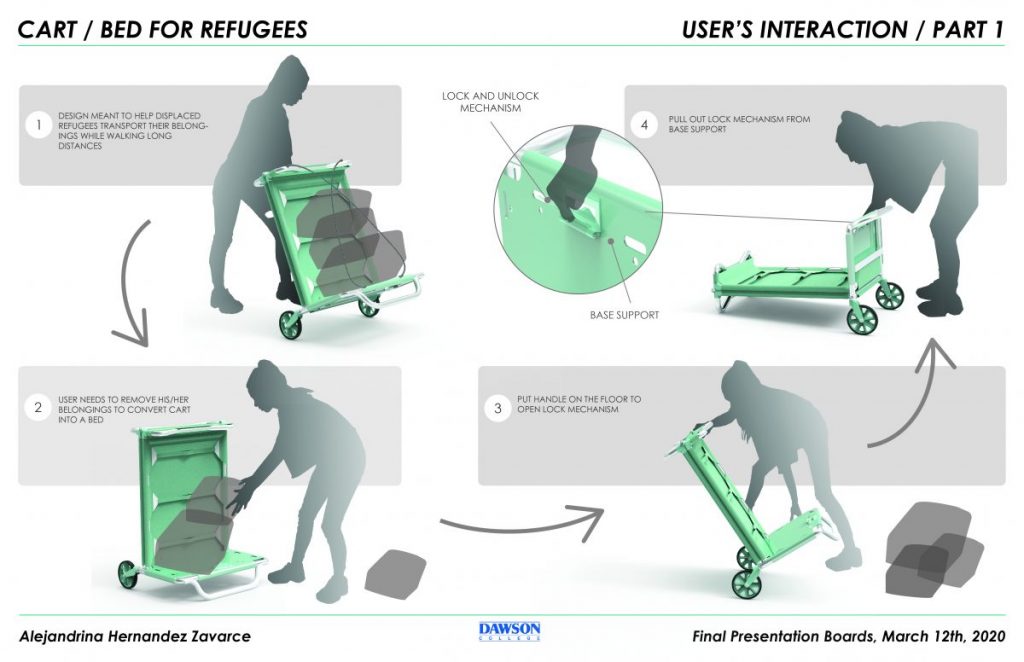Alejandrina Hernández Zavarce is 23 years old, a third-year student of Industrial Design at Dawson College in Montreal, Canada. She is the author of an invention that could impact the lives of Venezuelan refugees and migrants, a cart/bed: a cart that serves as a means for those who undertake the journey on foot to carry their belongings and at the same time a device that becomes a bed for rest.
“This allows people to rest and minimizes their suffering,” Hernández said in a piece on Dawson College’s website. Last May, her invention won the Bonnel Sustainable Design Award from the Extrusion Technology for Aluminum Profile Foundation.
The main structure of the cart/bed Hernandez created is made of aluminum. “As we know, aluminum is 100% recyclable, lightweight and low cost,” Hernandez said in the same university publication.
“Aluminum is lightweight and that reduces the suffering of those refugees who have less strength to carry their belongings,” she also told El Pitazo in an audiovisual report about her story.
“I applied three main principles: a social solution to partially reduce the suffering of refugees, the use of eco-friendly, recyclable materials, and economical principles in design and manufacturing, using a low-cost aluminum extrusion process, reducing the number of parts and facilitating the maintenance, repair, and durability of the product. As we know, aluminum is 100% recyclable, lightweight and low cost,” she explained in the Dawson College’s piece.
The cart/bed has two wheels. It comes with a locking and unlocking mechanism. When folded and locked, it serves as a trolley: the main structure can hold up to 150 kilos, and it has one upper handle bar for for pushing or pulling. The base support prevents the trolley from rolling on its own when stopped. The product can then be unloaded and unfolded, by unlocking the mechanism, to become a lightweight bed that does not take up much space and is resistant enough: it can hold up to 200 kilos.

Hernández left Venezuela for Canada with his parents in 2015. She grew up in Maracaibo, the capital of Zulia, a state located in the west of the country, bordering with Colombia. They left because things were already getting worse in their country.
“Migrating was hard for me. That’s why I understand refugees who leave all their belongings, their whole life, everything they grew up with, family, friends,” Hernández told El Pitazo.
She conceived the project in December 2018, when she returned from a visit to Venezuela. At that time, the diaspora was beginning to grow, spilling over the country borders.
“Near the Venezuelan/Colombian border I watched many people walking on the highway trying to cross the border into Colombia, looking for a better future for their family. It was shocking to see each member of the family, including children and old people, carrying their belongings, then resting and sleeping on any surface. Most of them seemed tired, sad, and confused, but determined to leave their country”, Hernandez said as quoted in the Dawson College website story.
“I remembered the time I was in Venezuela, in December 2018, and I said to myself, ‘This would be a good opportunity […] Considering that they travel long distances, I found out where they sleep, where they rest,” she told El Pitazo.
Hernández Zavarce thought that she could design some solution during her college degree studies –she will graduate in July this year — “and fulfil one of my life objectives, which is to help the poor and people with disabilities,” she added, according to the Dawson College’s piece.
Alejandrina Hernández has a hearing disability herself, as she states in her interview with El Pitazo. For her, communicating in Spanish is already a challenge; migrating to Canada and learning another language increased it, but she has overcome it.

In the fall of 2019 she found the opportunity to create the solution she had been dreaming of, when her teacher and tutor Michael Santella invited the students to participate in the competition that she later won.
“I also had the opportunity to show the real life of refugees,” she said.
Hernández said in the El Pitazo report that she is waiting for the foundation to publish the winners of the award.
“In the letter they told me, ‘well, soon we are going to announce the winners and that is going to be distributed to industries and engineers worldwide’.”
She then hopes to be able to make the prototype, so it can be tested with different users, and in the field, on various types of roads. “This would allow us to improve the product and promote its usability”, Hernandez told the Dawson College publication. She wants to add a roof to the bed part of the produc that would function as a tent, “to protect refugees from insects and weather!
UNHCR, Unicef and NGO’s distributing the final prototype is a possibility that has also been discussed with Hernández Zavarce at the foundation that awarded her the prize, according to her.
She will continue studying, for the time being. She was accepted at the University of Montreal. Then she wants to do a master’s degree. “And so I can continue to develop that knowledge, those skills, to help the most needy and those with low resources,” she told El Pitazo.
Images and photo taken from Dawson College’s website. The author of Hernández portrait is Anthony McLean
